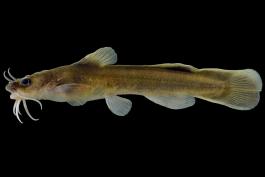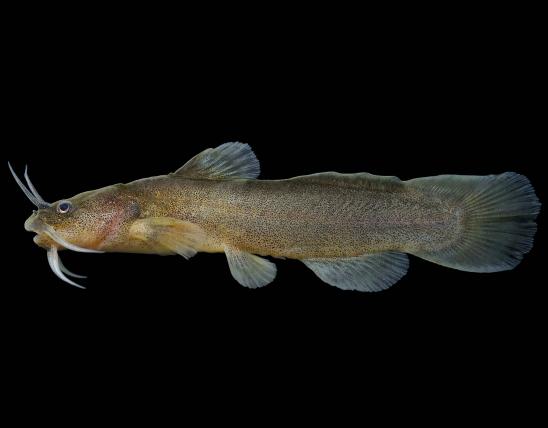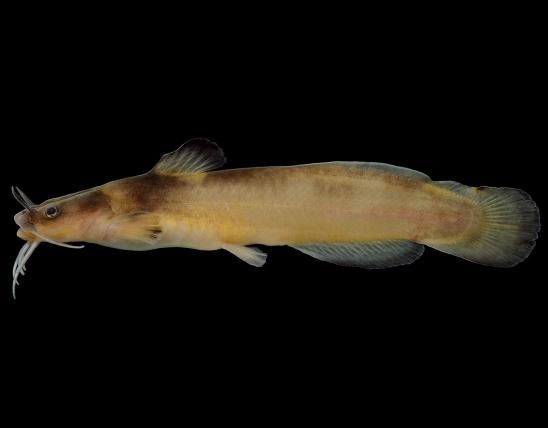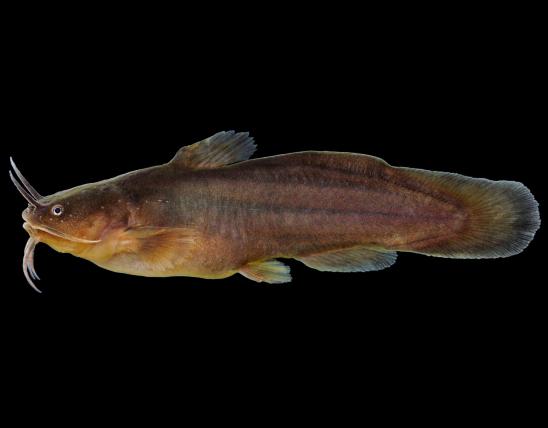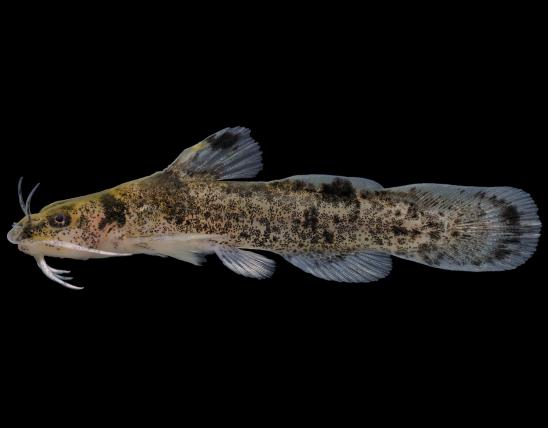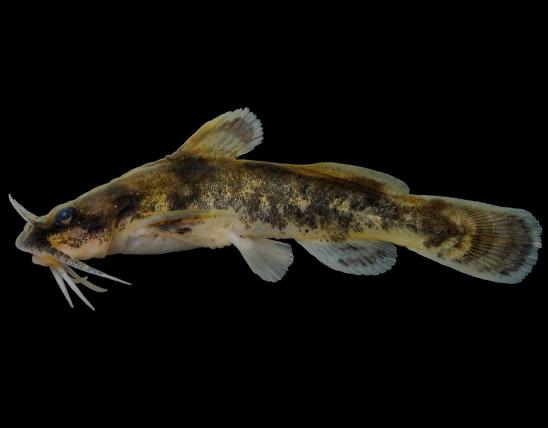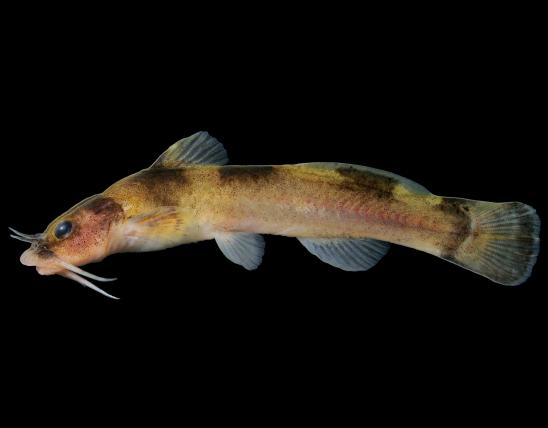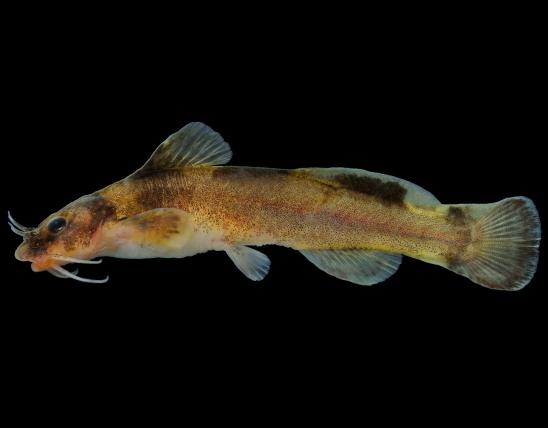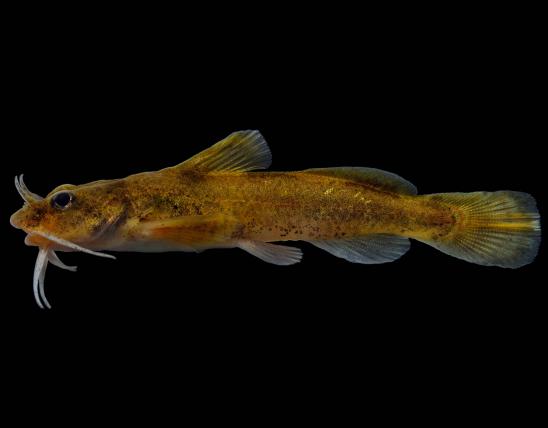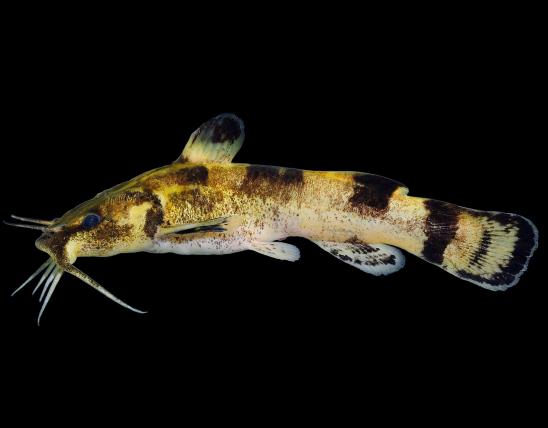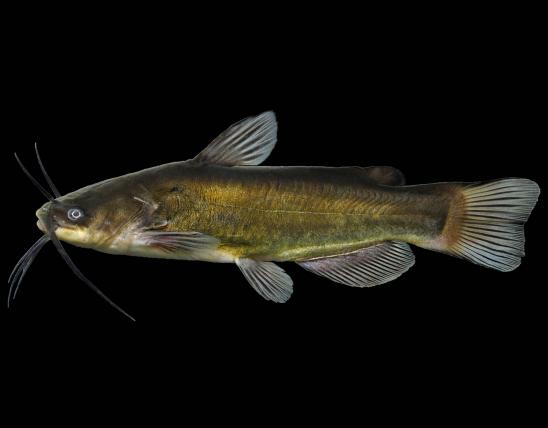
The stonecat is the most common madtom catfish in the large streams in the northern Ozarks and Prairie region. Its body and fins are nearly plain, its upper jaw projects beyond the lower jaw, and its lower lip and chin lack dark pigment.
Madtoms, as a group, are small, secretive catfishes that most people never see. The key identifier for madtoms has to do with the adipose fin (the small, fleshy fin that is present on the midline of the back just ahead of the tail fin). In madtoms, the adipose fin forms a low, keel-like ridge without a free, flaplike lobe along the trailing edge. The adipose may be connected to the tail fin, or it may have (at most) a slight notch in between. (In our other catfishes, the adipose fin forms a free, flaplike lobe, widely separate from the tail fin.)
The stonecat can be distinguished from our other madtoms by the following:
- The body is rather uniformly colored, without distinct blotches, bars, or speckles.
- The upper jaw projects well beyond the lower jaw.
- The pectoral fin spine is nearly smooth, lacking sawlike teeth on the back margin.
- It’s large for a madtom, up to 8 inches long.
- The pad of teeth on the upper jaw has a narrow, crescent-shaped, backward extension on each side.
- The lower lip and chin lack dark pigment.
- The notch between the adipose and tail fins is closer to the tip of the tail fin than to the dorsal fin base.
Most madtoms possess a mild venom that is associated with the pectoral and dorsal spines. When introduced into a puncture wound produced by the spine, the venom causes a painful reaction. The spines are often erected and locked in place when the madtom is alarmed, increasing the chance of a puncture. The venom is not considered dangerous to people, and the chances of being “spined” are not great if the possibility is kept in mind when handling a madtom. If you’ve been jabbed by a madtom spine and think you’re having a severe reaction, seek medical attention.
Similar species: Missouri has three other madtoms whose bodies are rather uniformly colored and lack distinct dark blotches, bars, or saddle marks: The slender, tadpole, and freckled madtoms. The slender and tadpole madtoms (N. exilis and N. gyrinus) have the upper and lower jaws about equal (the upper jaw does not overhang the lower jaw). The freckled madtom (N. nocturnus) shares with the stonecat the “overbite,” but it lacks the backward extensions on the teeth pad of the upper jaw, plus its lower lip and chin are heavily speckled with dark pigment.
There are about 30 species of madtoms (in the genus Noturus), and all occur in the central and eastern United States and nearby parts of Canada. In Missouri, 10 species of madtoms have been recorded. It can be difficult to separate the different species of madtoms using the traditional methods of fish ID (counting fin rays, for instance, or comparing ratios of body-part measurements). Noting differences in pigmentation (such as dark bars or patches) can help, but such coloration often varies by particular locality and habitat (such as amount of vegetation, turbidity, or different substrates). Color can also vary by a fish’s health, mood, breeding condition, sex, and individual genetics, and dead fish may show little coloration at all. Molecular (DNA) date is being used more and more as a way to separate the species; of course, it is not very useful in the field. Geography can be a good clue for species IDs, since different species may be restricted to certain stream systems and never occur in others.
Habitat and Conservation
The stonecat is the most common madtom in the large streams in the Prairie region of northern Missouri and in the northern Ozarks. In the headwaters of these streams, it is often replaced by the slender madtom. It also occurs commonly in the upper and middle sections of the Mississippi River but is rare in the lower Mississippi and Missouri rivers.
The stonecat lives in varied stream types but avoids those with intermittent flow or extremely high gradients. In stream systems where both occur, the stonecat is generally more abundant than the slender madtom in the largest rivers, but it is gradually replaced by that species toward the headwaters. In most streams, the stonecat occurs in riffles or runs having noticeable current and firm substrate that includes considerable loose rock. In the Missouri River, it is found in swift channels over sand substrates.
Like most other madtoms, the stonecat is most active at night, hiding by day in cover, such as beneath large rocks or in patches of detritus lodged in river sand.
Food
Life Cycle
Human Connections
These small catfish can inflict a painful puncture wound with the spines on their pectoral and dorsal fins. Like all of Missouri’s catfish species, madtoms have venom glands at the base of these fins. The glands secrete venom that becomes incorporated in the slime and cells that make up the spine. Because madtoms are so small, it's difficult to avoid their tiny, sharp spines, especially if you are trying to impale them on a fishing hook. Many describe the pain that comes from being “horned” by a madtom as similar to a bee or wasp sting. Others claim it to be much worse. It’s best to handle madtoms carefully.
Because stonecats cannot tolerate heavy siltation or pollution, their presence or absence in a stream is an indicator of water quality. Non-point-source pollution is an important concept for people to understand. It’s easy to see how dumping a pollutant right into a stream can degrade water quality, but it’s a little harder to grasp how oil, detergent, salt, fertilizer, or pesticide applied to land that seems far from a stream is ultimately washed into our waterways. It’s also harder to grasp how construction, plowing, or other soil disturbance on “dry land” can lead to siltation in nearby streams. Fortunately, people can learn these principles and take care to prevent our streams from being degraded.
Ecosystem Connections
Stonecats from the Missouri River and from the middle and lower Mississippi have much smaller eyes and a paler coloration than those from elsewhere in Missouri. These differences may be a response to environmental conditions, but the matter deserves further study.
We all know the story about the “big fish” eating the “little fish.” Madtoms are rather small, compared to other catfishes, and as such are more vulnerable to predation throughout their lives. The mildly venomous spines of the madtoms are one adaptation that helps them avoid being eaten.
Madtoms are part of the complex web of feeding relationships that occur in streams. Though small, madtoms are often abundant in streams, and their populations represent a significant link in the food chain.

